Activities that can be carried out with a Mini Excavator: Complete Guide
This article completes the chapter on using a mini excavator, which you can find here.
The mini excavator is a compact, versatile piece of construction equipment, ideal for carrying out a wide range of jobs in confined spaces. Its growing use in the construction and landscaping sectors makes it an essential tool. In this article we will explore all the activities you can do with a mini excavator in detail, focusing on its features and benefits. You will also find practical advice on how to safely and effectively handle this equipment.
1. Earthworks
Earthworks involve preparing the ground for construction or landscaping. This includes levelling the ground, excavating trenches and earth moving.
Earthworks is one of the main applications for the mini excavator. This machine is ideal for:
- Digging foundations: Mini excavators can be used to create precise foundations for houses, garages and other structures.
- Digging trenches: Whether it is installing electrical networks, pipes or irrigation systems, the mini excavator excels at digging deep, narrow trenches. The first layer of soil is often difficult to dig up because of the presence of roots.
- Pits and drainage: It can also be used to dig pits for rainwater drainage, contributing to water management on construction sites.
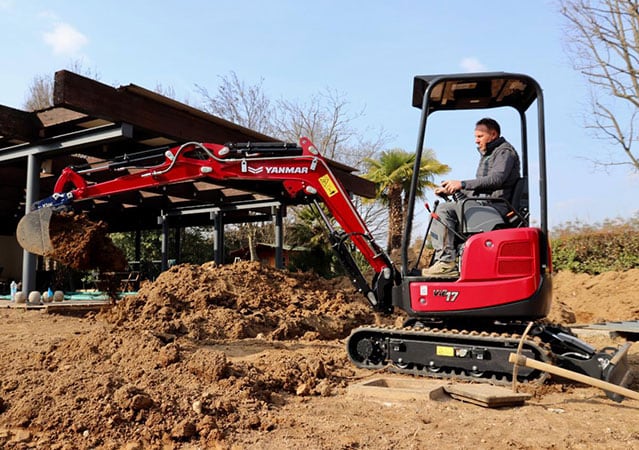
How to handle the mini excavator
- Site preparation: Before starting, mark out the work area and remove any obstacles.
- Positioning the mini excavator: Place the mini excavator on stable, flat ground.
- Using the hinged arm: Lower the arm and adjust the angle of the bucket for better grip.
- Movement: Move slowly to avoid losing control. Use the steering lever to steer the machine while keeping an eye on your surroundings.
2. Light demolition
The mini excavator is effective for light demolition work, including:
- Demolition of walls and structures: Thanks to its power and manoeuvrability, it can demolish brick walls, partitions and other light structures without damaging the surrounding area.
- Debris removal: After demolition, the mini excavator can be used to remove debris and clean up the site, preparing the ground for new work.
How to handle the mini excavator
1. Area preparation:
Before starting, examine the site to identify the structures to be demolished and the surrounding materials. Ensure that there are no electrical cables or underground pipes. Mark out the work area with barriers and inform people in the vicinity about the work.
2. Demolition of structures:
Start by gently tapping the structure to assess its strength. Gradually increase the force according to the response of the structure. Use the hydraulic hammer or bucket to strike the concrete from top to bottom, creating cracks. Once pieces of concrete have been broken off, use the bucket to lift and move them.
3. Cleaning and disposal:
Use the bucket to pick up debris and place it in skips or designated areas for disposal. If necessary, sort out materials that can be recycled. After demolition, inspect the area to ensure that no dangerous debris remains. If necessary, prepare the ground for the next stages of the project.
3. Landscaping
When it comes to landscaping, the mini excavator is an invaluable tool for:
- Creation of gardens: It makes it easy to move soil and create various landscaping features, such as paths and flowerbeds.
- Installation of terraces: The mini excavator can be used to dig foundations for wooden or stone terraces, ensuring a solid base.
- Plantations: With the right attachment, it can dig holes for planting trees, shrubs and perennials.
Landscaping with a mini excavator can be used to create gardens, pathways and ponds.
How to handle the mini excavator
4. Area preparation:
Define the outline of your project with stakes or rope.
5. Digging of trenches:
Use the bucket to dig the trenches needed for irrigation systems or paving foundations.
6. Placement of materials:
Load the bucket with materials such as gravel or earth and move them to the desired location.
7. Levelling:
For a neat finish, use the levelling blade to level the surface.
4. Roadworks
The mini excavator is widely used in road projects, in particular:
- Laying of pipelines: It excels at digging trenches to install water, gas or electricity pipelines, making infrastructure work easier.
- Road repairs: If necessary, the mini excavator can be used to repair roads by digging up damaged sections.
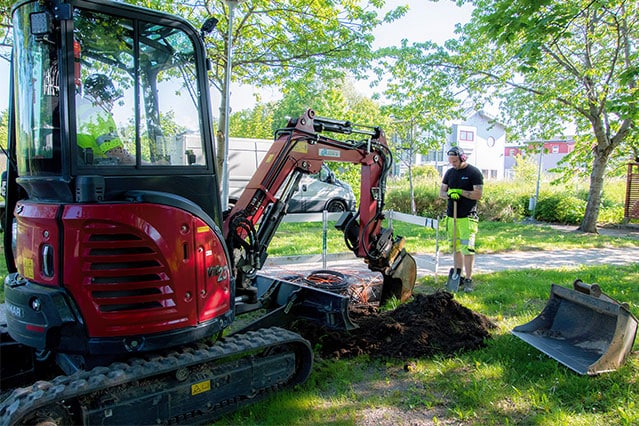
5. Excavation and levelling
The mini excavator is particularly suitable for excavation and levelling work:
- Soil excavation: Whether for foundation work or removing layers of earth, it can be used for quick and efficient evacuation.
- Levelling the ground: It is ideal for levelling surfaces, whether in gardens, sports fields or other fields.
Excavation involves removing earth to create pits, foundations or ponds.
How to handle the mini excavator
1. Tool selection:
Make sure you use a bucket suited to the depth and type of soil.
2. Excavation techniques:
- Straight line excavation: Lower the bucket into the ground and pull it towards you at a 30-degree angle.
- Wave excavation: Use a back-and-forth motion to remove debris more effectively.
3. Debris management:
Dispose of rubble at a safe distance to avoid any risk of collapse.
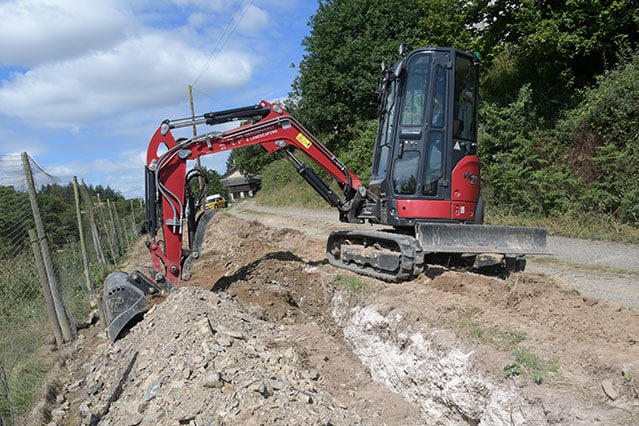
6. Installation of drainage systems
The mini excavator is often used to install drainage systems, by creating:
- Trenches for drains: It makes it possible to dig precise trenches for the installation of drainage systems, thus avoiding moisture problems on construction sites.
- Drainage pits: Pits dug by a mini excavator direct rainwater away from buildings and infrastructure.
Digging pits for foundations or septic tanks is a common task for mini excavators.
How to handle the mini excavator
1. Inspection of the ground:
Before digging, make sure there are no underground pipes or cables.
2. Digging technique:
Lower the bucket to the centre of the marked area and dig in circles to gradually widen the pit.
3. Depth monitoring:
Use visual markers or a spirit level to ensure that the desired depth is achieved.
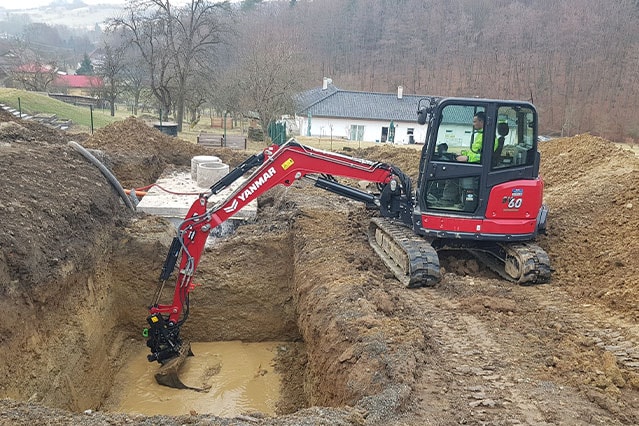
7. Pruning and bush clearance
When it comes to landscape maintenance, the mini excavator can help with:
- Removing tree stumps: Thanks to special attachments, it can uproot tree stumps, allowing optimum reuse of space.
- Bush clearance: It can be used to clear overgrown land, making sites more accessible.
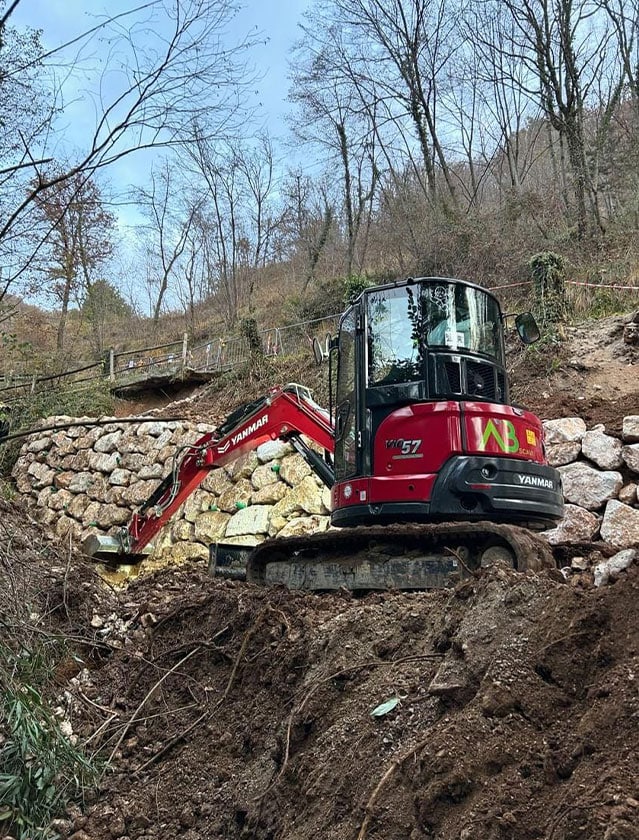
How to handle the mini excavator
1. Inspection of the ground:
Examine the work area carefully to identify any trees, bushes or scrub to be treated. Mark off the work area with cones or barriers to prevent accidents.
2. Digging technique:
Use a standard bucket to move and collect plant debris. For wider coverage when clearing undergrowth, a widening bucket can be useful. In some cases, an accessory such as a hydraulic shear can be used to cut thick branches.
Make sure the mini excavator is on stable ground. Deploy the stabilisers to ensure safety during work. Position yourself such that you have a good view of the work area, keeping an eye out for obstacles.
Pruning
1. Cutting of branches:
- Identification of branches: Locate the branches to be cut and assess their size.
- Using the bucket: Use the bucket to gently pull the branches downwards and break them. For thicker branches, a cutting attachment may be required.
2. Collection of debris:
- Loading: Once the branches have been cut, use the bucket to collect the debris and move it to a designated area for disposal.
- Stacking: Stack the debris in piles to make it easier to load and transport.
Bush clearance
1. Brush removal:
- Pulling plants: Use the bucket to grab and pull undergrowth and small trees. Take care not to damage the surrounding soil.
- Forward movement: Move forward slowly, using controlled movements to avoid overturning the machine.
2. Debris removal:
- Loading: Use the bucket to load debris into skips or designated areas.
- Sorting materials: If necessary, separate recyclable materials such as wood from green waste.
8. Construction and renovation projects
The mini excavator is essential for construction and renovation projects:
- Site renovation: It allows sites to be cleaned up, obsolete materials removed and the ground prepared for new projects.
- Construction of buildings: The mini excavator can be used for various aspects of construction, such as digging cellars or basements.
How to handle the mini excavator
Use a standard bucket for digging, levelling and excavating. A levelling bucket is recommended for levelling and smoothing surfaces. Depending on the job, consider using a bucket with teeth for hard ground or a hydraulic hammer for tough materials.
Excavation and digging:
- Preliminary marking: Before you start, mark the areas to be excavated or dug.
- Digging techniques: Lower the bucket into the ground, pulling towards you to scoop up the soil. Use slow, controlled movements to avoid losing control.
Levelling the ground:
- Using the levelling bucket: After excavation, use the levelling bucket to level the surface. Use lateral movements to ensure a smooth finish.
Moving of materials:
- Loading and transport: Load materials such as gravel, sand or concrete into the bucket and move them to the designated unloading areas.
- Debris handling: During renovation work, use the bucket to pick up and move debris.
Renovation of structures:
- Controlled demolition: Use the bucket to remove parts of existing structures, taking care to avoid damaging the desired parts.
- Backfill: After construction or renovation, fill the trenches and excavations with the appropriate material.
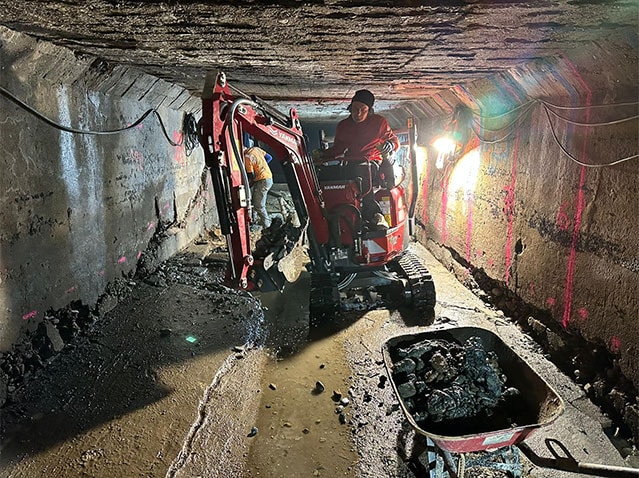
Conclusion
In short, the mini excavator is a versatile and efficient tool, capable of carrying out a multitude of activities in the construction and landscaping sectors. Whether it is earthworks, demolition, landscaping or roadworks, the mini excavator is indispensable on modern work sites. Its use not only optimises working time, but also guarantees high-quality results. Investing in a mini excavator is therefore a wise choice for any company or private individual who wants to carry out a wide range of jobs efficiently.